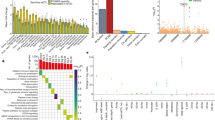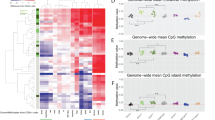Abstract
Several epidemiological studies on ataxia–telangiectasia families indicate that obligate ATM heterozygotes display an elevated risk for developing breast cancer. However, a molecular basis for a potential link between diminished ATM function and sporadic breast malignancy remains elusive. Here, we show that 78% (18 out of a panel of 23) of surgically removed breast tumors (stage II or greater) displayed aberrant methylation of the ATM proximal promoter region as judged by methylation-specific PCR. Aberrant methylation of the ATM promoter was independently confirmed in several tumors by bisulfite sequencing. Moreover, bisulfite sequencing indicated that this region of the genome is subject to dense methylation. Further, we found a highly significant correlation (P=0.0006) between reduced ATM mRNA abundance, as measured by real-time RT–PCR, and aberrant methylation of the ATM gene promoter. These findings indicate that epigenetic silencing of ATM expression occurs in locally advanced breast tumors, and establish a link at the molecular level between reduced ATM function and sporadic breast malignancy.
This is a preview of subscription content, access via your institution
Access options
Subscribe to this journal
Receive 50 print issues and online access
$259.00 per year
only $5.18 per issue
Buy this article
- Purchase on Springer Link
- Instant access to full article PDF
Prices may be subject to local taxes which are calculated during checkout




Similar content being viewed by others
References
Ai L, Vo QN, Zuo C, Li L, Ling W, Suen JY, Hanna E, Brown KD and Fan CY . (2004). Cancer Epidemiol. Biomarkers Prev., 13, 150–156.
Angele S, Treilleux I, Taniere P, Martel-Planche G, Vuillaume M, Bailly C, Bremond A, Montesano R and Hall J . (2000). Clin. Cancer Res., 6, 3536–3544.
Athma P, Rappaport R and Swift M . (1996). Cancer Genet. Cytogenet., 92, 130–134.
Bebb DG, Yu Z, Chen J, Telatar M, Gelmon K, Phillips N, Gatti RA and Glickman BW . (1999). Br. J. Cancer, 80, 1979–1981.
Bernstein JL, Bernstein L, Thompson WD, Lynch CF, Malone KE, Teitelbaum SL, Olsen JH, Anton-Culver H, Boice JD, Rosenstein BS, Borresen-Dale AL, Gatti RA, Concannon P and Haile RW . (2003). Br. J. Cancer, 89, 1513–1516.
Byrd PJ, Cooper PR, Stankovic T, Kullar HS, Watts GD, Robinson PJ and Taylor MR . (1996). Hum. Mol. Genet., 5, 1785–1791.
Chenevix-Trench G, Spurdle AB, Gatei M, Kelly H, Marsh A, Chen X, Donn K, Cummings M, Nyholt D, Jenkins MA, Scott C, Pupo GM, Dork T, Bendix R, Kirk J, Tucker K, McCredie MR, Hopper JL, Sambrook J, Mann GJ and Khanna KK . (2002). J. Natl. Cancer Inst., 94, 205–215.
Easton DF . (1994). Int. J. Radiat. Biol., 66, S177–S182.
Esteller M, Corn PG, Baylin SB and Herman JG . (2001). Cancer Res., 61, 3225–3229.
Fang ZM, Lee CS, Sarris M, Kearsley JH, Murrell D, Lavin MF, Keating K and Clarke RA . (2001). Pathology, 33, 30–36.
FitzGerald MG, Bean JM, Hegde SR, Unsal H, MacDonald DJ, Harkin DP, Finkelstein DM, Isselbacher KJ and Haber DA . (1997). Nat. Genet., 15, 307–310.
Gueven N, Keating K, Fukao T, Loeffler H, Kondo N, Rodemann HP and Lavin MF . (2003). Genes Chromosomes Cancer, 38, 157–167.
Gueven N, Keating KE, Chen P, Fukao T, Khanna KK, Watters D, Rodemann PH and Lavin MF . (2001). J. Biol. Chem., 276, 8884–8891.
Herman JG, Graff JR, Myohanen S, Nelkin BD and Baylin SB . (1996). Proc. Natl. Acad. Sci. USA, 93, 9821–9826.
Jones PA and Baylin SB . (2002). Nat. Rev. Genet., 3, 415–428.
Kairouz R, Clarke RA, Marr PJ, Watters D, Lavin MF, Kearsley JH and Lee CS . (1999). Mol. Pathol., 52, 252–256.
Kim WJ, Vo QN, Shrivastav M, Lataxes TA and Brown KD . (2002). Oncogene, 21, 3864–3871.
Rotman G and Shiloh Y . (1998). Hum. Mol. Genet., 7, 1555–1563.
Shafman TD, Levitz S, Nixon AJ, Gibans LA, Nichols KE, Bell DW, Ishioka C, Isselbacher KJ, Gelman R, Garber J, Harris JR and Haber DA . (2000). Genes Chromosomes Cancer, 27, 124–129.
Swift M, Reitnauer PJ, Morrell D and Chase CL . (1987). N. Engl. J. Med., 316, 1289–1294.
Vo QN, Geradts J, Gulley ML, Boudreau DA, Bravo JC and Schneider BG . (2002). J. Clin. Pathol., 55, 669–675.
Acknowledgements
We thank Mr Alberto Delgado, Ms Megan Bronson, Ms Mamie Yu and Ms San-San Ng for expert technical assistance. This work was supported by grants from the NIH (R21 CA102220), the A-T Children's Project and the Louisiana Breast Cancer Task Force/Cancer Association of Greater New Orleans to KDB. QNV was supported, in part, by a postdoctoral fellowship from the Stanley S Scott Cancer Center.
Author information
Authors and Affiliations
Corresponding author
Rights and permissions
About this article
Cite this article
Vo, Q., Kim, WJ., Cvitanovic, L. et al. The ATM gene is a target for epigenetic silencing in locally advanced breast cancer. Oncogene 23, 9432–9437 (2004). https://doi.org/10.1038/sj.onc.1208092
Received:
Revised:
Accepted:
Published:
Issue Date:
DOI: https://doi.org/10.1038/sj.onc.1208092
Keywords
This article is cited by
-
Expression variations of DNA damage response genes ATM and ATR in blood cancer patients
Molecular Genetics and Genomics (2023)
-
SCGB3A1 gene DNA methylation status is associated with breast cancer in Egyptian female patients
Egyptian Journal of Medical Human Genetics (2021)
-
Targeting DNA repair in cancer: current state and novel approaches
Cellular and Molecular Life Sciences (2020)
-
Chemically induced carcinogenesis in rodent models of aging: assessing organismal resilience to genotoxic stressors in geroscience research
GeroScience (2019)
-
WSB1 overcomes oncogene-induced senescence by targeting ATM for degradation
Cell Research (2017)



